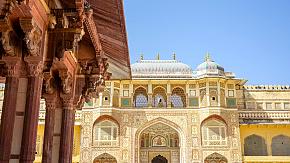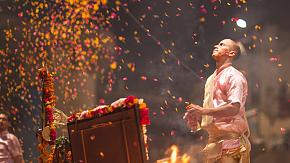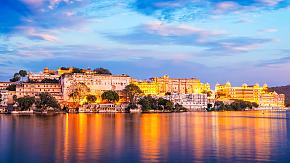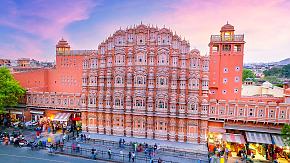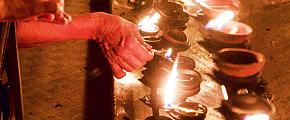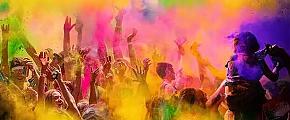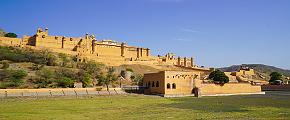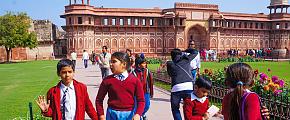Top 10 India's Forts and Palaces You Must See
India has accepted profound cultural currents to shape its own features. It is full of forts and palaces that allure a growing number of tourists across the world. All, whether the Agra Fort or the City Palace, are treasures that India leaves for the world. Here, we recommend you India's must-see forts and palaces, where you can travel around every site in awe and amazement, and get close to history and traditions during your trip to India.
Red Fort Complex
The Red Fort Complex, which served as the royal palace, is the product of the relocation of the capital from Agra to Delhi during the Mughal dynasty. Built of red sandstone in the 17th century, it is surrounded by massive enclosing walls and a moat and has the same reddish-brown color as the Agra Fort Complex. Overlooking the east bank of the Yamuna River in Delhi, the complex is based on the design of the Agra Fort Complex. It is an ideal blend of Islamic prototypes and Hindu, Persian, Arabic, and Mongolian decorations and bears witness to the grandeur and decline of the Mughal Empire.
The 500-year-old fort remains appealing to tourists around the world. There are many functional halls in the fort, such as Khas Mahal, used for receiving distinguished envoys and officials from across the world, and Diwan-i-Khas, used to discuss official business. At first sight, it is like a legendary castle in a cartoon fairytale. It features a strictly symmetrical structure, and its pillars and walls bear sculpted reliefs in the shape of flowers and figures. The windows carved out of entire slabs of white marble are decorated with many types of gems. Walking along the passages in the fort, you will be impressed by its magnificent and dazzling beauty.
Agra Fort
The Taj Mahal, gleaming with white marble, is one of India's famous landmarks, and not far away is a red building that stands in stark contrast to it - the Agra Fort.
Agra Fort is situated on the right bank of the Yamuna River in Agra, which served as the seat of government and the royal palace during the reign of the Mughal Empire. Although the capital was moved to Delhi in 1638, Agra Fort still plays an important role. It represents the Islamic architectural zenith, reflects the past splendor of the Mughal Dynasty in India, and was included as a World Heritage Site in 1983.
Encircled by 12-meter-tall walls, the sandstone fort is constructed on a semicircular design, and massive columns to support the weight of the fort are evident, showing magically reddish-brown. The fort houses a number of historical buildings, including the Pearl Mosque (Moti Masjid) and the Jahangiri Mahal. The Pearl Mosque is beautifully designed of white marble while the Jahangir Mahal is built of red sandstone and decorated with white marble. The carvings and decorations incorporate elements of Islamic art and Hinduism, resulting in a unique and exquisite artistic style that showcases the splendor of Mughal Empire architecture.
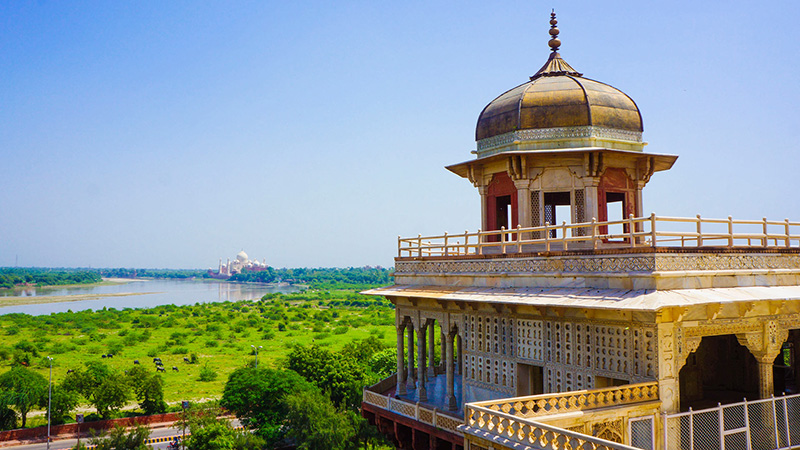 Agra Fort
Agra Fort
Mysore Palace
The Mysore Palace, the most glorious symbol of the Mysore Kingdom, is located in Mysore, the cultural and historical center of Karnataka. The original palace was razed to the ground by fire due to war, and the present Mysore Palace was designed and built by an English architect, Henry Irwin, in 1912. As a result, this magnificent palace is a perfect fusion of ancient Indian, Islamic, and British royal architectural styles, making it an artistic treasure for India and the rest of the world.
Mysore Palace is a unique structure with a graceful exterior and eight small and delicate Islamic rose-colored domes on its roof. The top of the inner palace is covered with stained glass and painted with magnificent feathers and peacocks. The walls and floors are covered with tiles decorated with various splendid patterns. Inside, you can see many beautiful wood carvings, paintings, and ornaments, as well as perhaps an unfamiliar modern elevator.
Additionally, countless bright lights are lit up inside and outside the palace every day, giving you a different surprise and experience at night, unlike the quietness of the day. By the way, if you are a yoga lover, don't miss Ashtanga Yoga, which originated in Mysore.
Umaid Bhawan Palace
In addition to the Mehrangarh Fort, Jodhpur, the romantic "Blue City", is home to a famous royal palace: the Umaid Bhawan Palace, a magnificent royal palace in the western Rajasthan State, which serves as a landmark of Jodhpur. Built in 1929, the Umaid Bhawan Palace is a large private residence in India. It was designed by the British architect Henry Vaughan Lanchester. The marble-made palace boasts 347 rooms and a garden of 26 acres.
Today, parts of the palace have been established as a luxury hotel, with a museum and library that house a rich collection of books, treasures, clocks, and souvenirs. Although the Umaid Bhawan Palace was not built long ago, its ancient Indian architecture gives you a glimpse of its past glory, and the palace itself is a perfect testament to Jodhpur's integration into modern times. It is now equipped with recreational facilities such as restaurants, cabarets, banquet halls, swimming pools, and various playing courts. So, when you come to Umaid Bhawan Palace, you can not only visit the stunning architecture but also experience the modern comforts of life.
Amber Fort
Amber Fort, one of the most prestigious forts in India, is situated on a hill named Amber in the suburbs of Jaipur in Rajasthan State. It was built using red as well as white stone marble by Emperor Man Singh in 1592. The fort, fusing the Islamic prototype with a Hindu style, is famed for its grand ramparts, decorated gates, and delicate cobbled paths.
Amber Fort includes several palaces built during different periods, such as the Sheesh Mahal, also known as the "Palace of Mirrors", featuring a unique design with countless pieces of glass and gems inset into its walls. In Sheesh Mahal, even the smallest glimmer of light cast on the walls can create a breathtakingly beautiful view. Furthermore, windows, marble pillars, and fort paths are adorned with exquisite carvings in various shapes. Wherever you visit Amber Fort, you may take in its glory.
In addition, the Light and Sound Show, held in Amber Fort and starts from 6:30 pm every night, is a special experience you can't miss. Lights will illuminate the entire Amber Fort, lasting about 50 minutes, during which you will gain knowledge of ancient anecdotes. It shows Jaipur's unique charm, and you can watch it from the bottom of the hill at night.
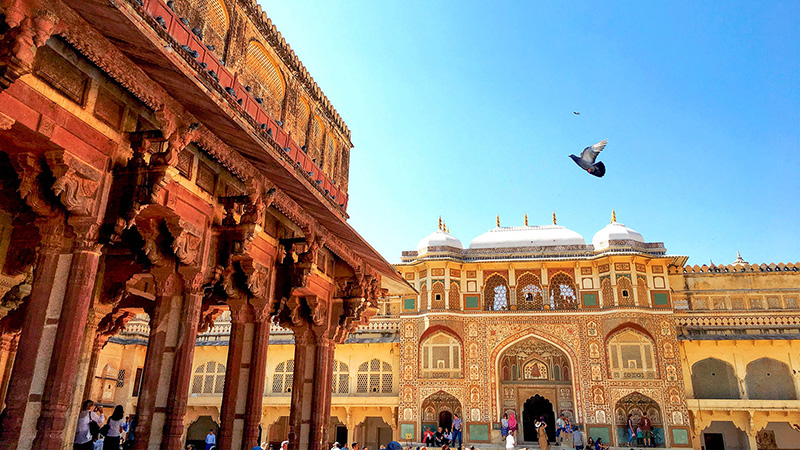 Amber Fort
Amber Fort
Jaipur City Palace
Don't fail to visit the City Palace, a complex of pink palaces in the heart of the old city of Jaipur, the capital of Rajasthan. The magnificent complex, one of the masterpieces of Indian cultural monuments, was built mainly of red sandstone in a flawless blend of Indian, Islamic, Persian, and European styles. You will surely be struck by a rose-pink palace shaped like a hexagonal beehive.
On the eadge of the City Palace, it's the "Hawa Mahal", also known as the "Wind of Palace", and is Jaipur's landmark and draws photographers from all over the world. It has five floors, covered with 953 small pink windows of special construction and inlaid with white-blue glass and various carvings. It is worth mentioning that the sunlight passes through the numerous small holes in this building, especially in the early morning and at sunset, when the glass in the windows reflects the sunlight, creating a scene of stunning brilliance.
In addition, the museum in the center of the Pink Palace is worth seeing, with its many collections of ancient weapons, rugs, paintings, and curiosities on exhibition. This is a great opportunity for your children to learn about the architecture and history of India. Maybe it will take a lot of time to appreciate its charm, but you'll certainly get a lot out of it.
Jaisalmer Fort
Have you seen a magnificent fort in the desert? Are you curious about this unimaginable scene? Locals in Jaisalmer have created such a wonderful masterpiece for India and the rest of the world. Jaisalmer Fort absolutely meets the needs of your fancy and curiosity.
Standing on the edge of the Thar Desert in Jaisalmer, the illusion-like fort, with a history of over 800 years, is made distinctively of yellow sandstone, which is elaborately carved. The city is literally born in Jaisalmer Fort, which is home to thousands of people who have never left their hometown for generations.
It is full of life and has been a residence where locals work and live. The streets of the fort are lined with a plethora of shops and hotels, and the market here is packed with crowds. The vigor that Jaisalmer Fort shows to you makes it one of the unique forts in India and more and more popular across the globe.
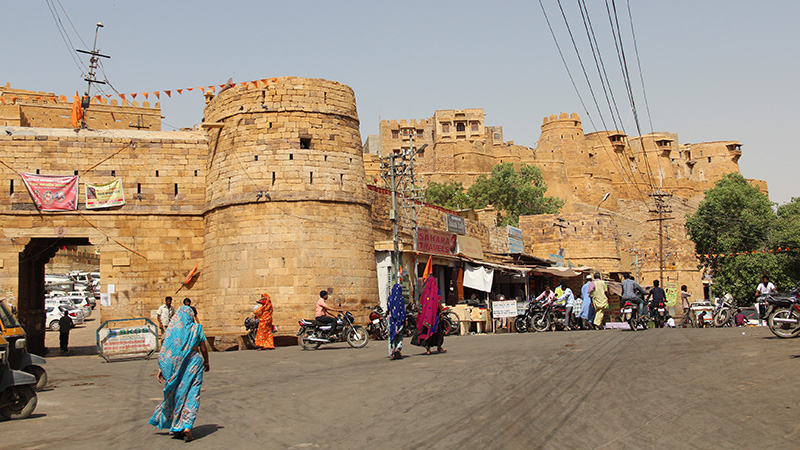 Jaisalmer Fort
Jaisalmer Fort
Lake Palace
Voted as the best city to visit in the world by the famous travel magazine Travel + Leisure, Udaipur, is also famous for another landmark, the Lake Palace. Placed in the center of Lake Pichola, and built by Emperor Maharana Jagat Singh II in 1746 as a summer residence, it is made of white marble and resembles a white jewel inlaid in the heart of the lake.
The Lake Palace has been converted into a five-star luxury hotel, making it an excellent choice for a night's stay after visiting the City Palace during the day. It is the ultimate experience to come in and out of the palace and take a tour of the lake on a luxury yacht. During the day, you can admire the jade-like surfaces of the palace, shimmering with the sunlight. At night, the light show that adorns the palace is the most fascinating view around here, and you can take a yacht ride on the lake to look at the palace decorated with resplendent and highly luxurious light.
Udaipur City Palace
If you're new to Udaipur, the White City, you can't miss the City Palace. This palace was first built by the city's founder, Udai Singh II, in the 16th century and was later expanded by several emperors. And this is how it is now: a complex of several separate palaces.
Overlooking the lake and its surroundings, the City Palace, one of the landmarks of Udaipur, is built of white marble on the bank of the city's Lake Pichola. The architecture is a blend of Islamic and European styles, and its interior and exterior are covered with elaborate decorations. Many of the decorations are handmade, including elegant lamps, gorgeous carvings, floors, and frescoes. The palace's walls, on which some of the windows are inlaid with colorful glass, are carved with portraits of kings from different periods and vividly exquisite peacocks.
Because Udaipur receives a lot of sunlight all year, the corridors of the palace are always filled with colorful light and shadows of glass and gems. You can also stand at the highest point of the palace and see the entire city. Whether you walk inside the palace or look out over the lake, you will be struck by its luxury and splendor. Some back gardens of the palace are still available to the public for rent as a venue for weddings or major festivals, so if you're lucky enough to stumble upon one, be sure to attend.
Gwalior Fort
Gwalior, known for its ancient history and magnificence, is considered one of the most desirable forts in India. Located in Gwalior city, northwest of Madhya Pradesh, Gwalior Fort was built to defend against foreign invasion, and it has been destroyed and expanded through many dynasties.
The present scale of the fort, consisting of of two main palaces: the Gujari Mahal and the Man Mandir Palace, was formed during the reign of the Rajput Tomar dynasty. The outer walls of the palaces are covered with blue mosaics and carved with rows of yellow ducks. Some of the walls and pillar tops are carved with elephants, peacocks, dragons, and other animals. In addition to the two most magnificent palaces, Gwalior Fort also includes many historical sites, such as Hindu and Jain temples and archaeological museums. What's more, the fort is scattered with crumbling old buildings, and you will be struck by the ancient and turbulent history they hold.
It is recommended that you visit the fort until dusk when the afterglow will turn the entire fort into a golden color, which forms a magnificent view as if the ancient fort has regained its glory. Even in the evening, you can't miss the fort. A grand Sound and Light Show is held in the amphitheater in the fort every evening, which will add a chic and modern touch to this ancient complex.
Unveil Mysteries of India With Odynovo
As Mark Twain praised India, "India is the cradle of the human race, the birthplace of human speech, the mother of history, the grandmother of legend, and the great-grandmother of tradition." The ten above-mentioned palaces and forts are just a small part of India's cultural heritage sites. If you travel throughout the big land, you must be stunned by its cultural diversity. India is an ancient but colorful country that travelers across the world should go to for a break. If you're planning a special trip to ancient monuments in India, please don't hesitate to contact us or write to [email protected], and one of our travel experts can create a tailor-made itinerary to meet your requirements within 24hrs.
Quick Question
Related Posts You May Like
What Our Clients Say
Explore the latest verified reviews of Odynovo's travel services on Tripadvisor, Google, Trustpilot, Product Review and more trusted platforms.
SUBSCRIBE TO WIN A FREE TOUR
Subscribe to our newsletter for a chance to win a free 7-day tour to India! And more insider travel news, exclusive offers, and inspiration will be sent straight to your inbox. Check our previous newsletters and get some sparks.

